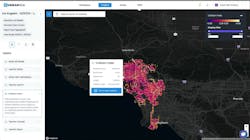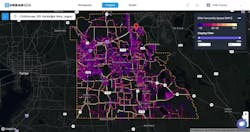OFFICER Labs: Urban SDK Offers Police Smart Traffic Management
What to Know
- Urban SDK provides real-time traffic metrics derived from connected vehicle data, enabling swift enforcement actions.
- The system can be deployed within approximately 24 hours, making it highly responsive to traffic safety needs.
- Agencies can automatically receive alerts about high-speed incidents, optimizing patrol deployment.
- Urban SDK's solution is cost-effective and tailored to the size of each jurisdiction, with proven success across numerous states.
More on OFFICER.com
Download the September/October issue of OFFICER Magazine.
Click Here to subscribe to OFFICER Magazine.
How many times in the course of your career have you taken a phone or in-person citizen complaint about a vehicle speeding, running a stop sign, taking corners too fast, etc.? Now, of all those times, how many were you able to take any action on? If you got enough complaints of the same nature in the same location, you probably were able to do something. A patrol car was assigned to sit and watch an intersection to cite violators or a team might have been assigned to do targeted speed enforcement. But the process to get to any enforcement effort could take weeks or months to get to because there had to be sufficient anecdotal “evidence” to justify the expenditure of manpower. And a large chunk of that “evidence” is inaccurate public perception. That begs the question: What if you could have actionable evidence (notice the lack of quotes) in just minutes?
Enter Urban SDK. Headquartered in Jacksonville, Florida, Urban SDK is a geospatial AI company, founded in 2018, and now providing real-time access to speed and traffic data to its clients, 24/7 within specified boundaries. The Urban SDK system enables local partners (client agencies) to have access within the jurisdictional boundaries to traffic metrics. In this manner, the local partners know exactly where there are speed violation challenges on their roadways so they can deploy enforcement manpower appropriately and with confidence that it’s not a waste of budget resources.
Because the traffic metrics are continuously tracked, the agency partner can not only show the data justifying the enforcement effort, but the impact of the enforcement during and after the fact. Such data availability and use empowers the agency partner to communicate with the community served, showing the public safety need and the direct results of the targeted enforcement.
Our team’s question was, “How does Urban SDK get the data it uses to provide the traffic metrics data?” Urban SDK derives their data from connected vehicles. A “connected vehicle” is any vehicle with smart technology embedded in it, but it’s important to know and understand that Urban SDK does not have, access or record any proprietary information on the vehicles.
Such a complex AI-driven system must cost a ton and take months to deploy, right? Wrong. Per the staff at Urban SDK, average time from contract initiation to operation is approximately 24 hours. When asked how the training curve could be covered so quickly, we discovered that the system is so intuitive it takes little training to be used, but Urban SDK still supports each license/customer through training and onboarding and throughout the entirety of the contract of service. The onboarding process itself is custom tailored to each customer.
The system is a web-based platform that can be accessed from any patrol vehicle laptop, office computer, etc. It can even be accessed from mobile devices such as tablets or smart phones, however those devices usually have less core processing capability and that slows down the delivery of requisite data to support the system. You still get all the same valuable information, just not as fast.
Imagine being able to know exactly where your jurisdiction is seeing the challenge of speeding vehicles… per shift or per day. Imagine if the system could automatically send your supervisory and command staff a message when it “saw” high incidents of speeding. You don’t have to imagine: With its latest deployment, Urban SDK can do exactly that and does so for over 250 agencies in 39 different states (when we interviewed them).
You might think that such a system has to have a high cost but the cost depends on the size of your agency and jurisdiction. The base cost includes five administrative accessors and whatever number of miles of roadway are in your jurisdiction.
Because this type of AI-driven data empowers greater efficiency in traffic safety enforcement, and because it’s seeing success in such a wide variety of locations, OFFICER Media Group is proud to award Urban SDK our “Tested - Field Rated” seal of approval.



